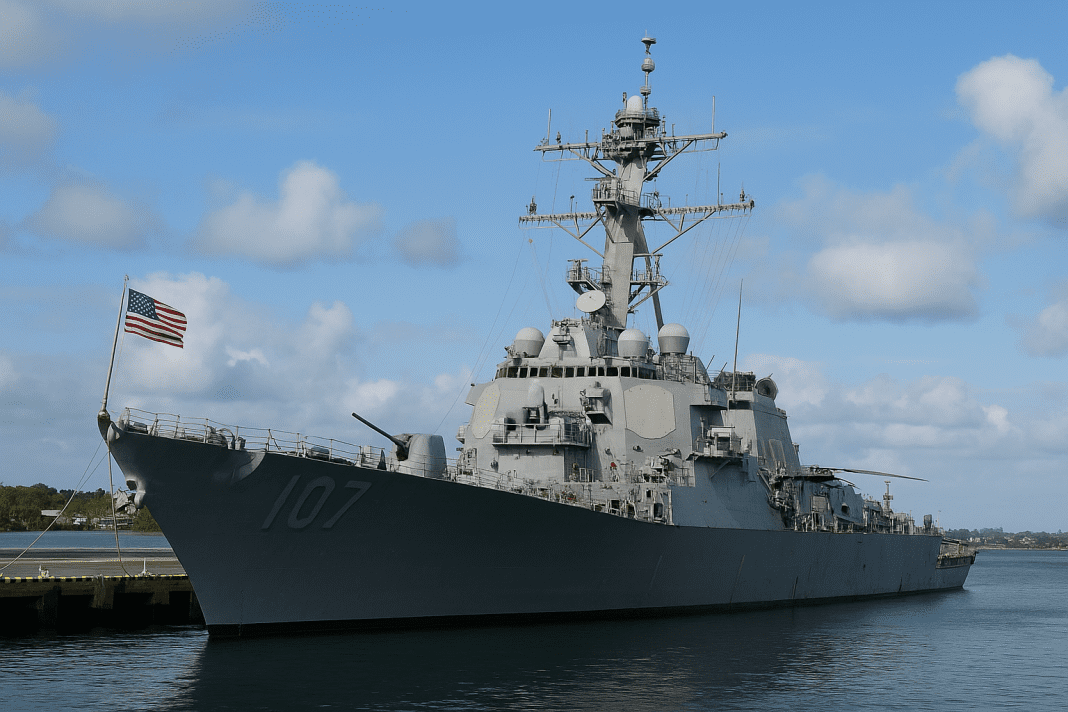A powerful U.S. Navy warship has arrived in Trinidad and Tobago, only a short distance from Venezuela’s coast. The vessel, named USS Gravely, is an advanced destroyer equipped with guided missiles, helicopters, and U.S. Marines. Its sudden presence has triggered a strong and angry reaction from Venezuela, which has accused the United States of staging a military provocation close to its territorial waters.
Rising Tensions in the Caribbean
According to official reports, the USS Gravely docked in Port of Spain, the capital of Trinidad and Tobago, on Sunday. The ship’s arrival is part of joint military exercises between the U.S. Navy and Trinidad and Tobago’s defense forces. U.S. officials have described the drills as routine cooperation focused on regional security and countering illegal trafficking operations.
However, the reaction from Venezuela was immediate and fierce. Its government denounced the move, calling it a serious threat to peace and stability in the region. Officials claimed that the joint activity was coordinated by foreign intelligence and designed to increase tension in the Caribbean Sea.
US stations F-35 aircraft in Puerto Rico amid wider military presence in Caribbean
The dispute has now placed the small island nation of Trinidad and Tobago in the middle of a growing geopolitical confrontation. Its government confirmed that the U.S. destroyer would remain docked until Thursday for planned exercises, including training in naval defense and security operations.
The USS Gravely and the U.S. Military Buildup
The USS Gravely, an Arleigh Burke-class destroyer, is one of the U.S. Navy’s most advanced warships. Weighing about 9,000 tons, it carries Tomahawk missiles, anti-aircraft systems, and powerful radar. The ship also hosts helicopters and Marines, giving it both defensive strength and quick-response capability.
Along with the Gravely, the aircraft carrier USS Gerald R. Ford and its strike group—made up of cruisers, destroyers, and surveillance aircraft—have moved into the Caribbean. This combined force represents one of the largest U.S. naval deployments in the area in recent decades.
Venezuela increases reliance on USDT for oil sales as PDVSA seeks alternatives to blocked payments
Washington says the mission supports U.S. Southern Command’s operations to stop smuggling, monitor threats, and protect trade routes. Military officials describe it as part of a long-standing plan to boost regional cooperation and maritime security.
However, Venezuela views the buildup as a potential provocation. With U.S. troops stationed on several warships and in Puerto Rico, and recent strikes on suspected trafficking vessels, concerns are growing that the deployment signals more than routine security operations.
Regional Reaction and Diplomatic Fallout Involving USS Gravely
Venezuela’s government has accused its Caribbean neighbor and the U.S. of acting together to provoke a conflict. It called the joint exercises an “act of aggression” and labeled Trinidad and Tobago a “military colony” serving foreign interests. The country’s leadership warned that such activities risk pushing the region toward instability and could ignite an unwanted confrontation.
Officials in Trinidad and Tobago have maintained that the visit is a peaceful and cooperative mission aimed at improving defense coordination and regional security. They stated that the exercises will involve training in coastal defense, maritime search, and rescue operations, with no offensive objectives.
U.S. defense officials say the mission is part of a long-term plan to secure trade routes and fight organized crime in the Caribbean. They describe it as one piece of a larger network of regional operations.
Still, the situation is tense. The Caribbean, once known mainly for trade and tourism, now shows clear signs of growing military and political rivalry. While the U.S. insists its presence ensures security, Venezuela views it as a show of force.
The USS Gravely’s arrival has also drawn global attention because of Venezuela’s close ties with Russia, China, and Iran. With its vast oil reserves and strategic location, the area remains under close watch as naval exercises and diplomatic exchanges continue near its shores.

